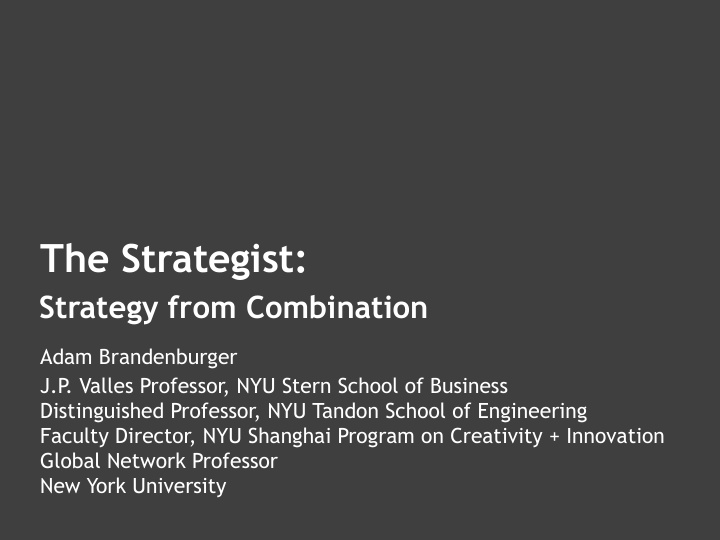



The Strategist: Strategy from Combination Adam Brandenburger J.P . Valles Professor, NYU Stern School of Business Distinguished Professor, NYU Tandon School of Engineering Faculty Director, NYU Shanghai Program on Creativity + Innovation Global Network Professor New York University
http://oeis.org/A000522/b000522.txt 2
https://en.wikipedia.org/wiki/Sonnet_59#/media/File:Sonnet_59_1609.jpg 3
https://www.bose.com/en_us/products/wearables/frames.html; 4 my thanks to Ameya Shanbhag for this example
“Strategy Needs Creativity” Adam Brandenburger Harvard Business Review , March-April 2019 Combination — how to begin? Form groups with diverse expertise and experience; brainstorm new combinations of products and services Look for ways to coordinate with providers of complementary products (who may even be competitors) Combination — what to watch our for? Businesses often manage for and measure profits at the individual product or activity level But combinations require system-level thinking and measurements 5
The Value Net Customers The Competitors Complementors Enterprise Suppliers Adam Brandenburger and Barry Nalebuff, Co-opetition , Doubleday 1996 6
The Value Ladder Willingness-to-Pay $ Price $ Cost $ Supplier Cost $ Adam Brandenburger and Harborne Stuart, “Value-Based Business Strategy,” Journal of Economics 7 & Management Strategy , 5, 1996, 5-24
Competition and Complementarity Two businesses A and B are complementors with respect to a customer if W2P( A & B ) W2P( A ) + W2P( B ) ≥ They are competitors with respect to a customer if W2P( A & B ) W2P( A ) + W2P( B ) ≤ They are complementors with respect to a supplier if SC( A & B ) SC( A ) + SC( B ) ≤ They are competitors with respect to a supplier if SC( A & B ) SC( A ) + SC( B ) ≥ 8
“Consider the world’s greatest challenges --- from climate change to resource scarcity to inequality. Did any one institution, or any one sector, create these challenges? Absolutely not. These are shared challenges, and for that reason, the solutions can only be collaborative. Collaboration --- in the right balance with competition --- can drive value, too --- for businesses, and for the planet. In their book Co-opetition , Adam Brandenburger and Barry Nalebuff describe just such a balance --- a new kind of business strategy in which companies work together to develop products and markets in an attempt to expand opportunities for all.” -- Indra Nooyi, Chair and CEO, PepsiCo Prepared remarks for BSR Conference 2014; quoted with permission 9
Cooperation in the Face of Competition Some considerations in deciding whether or not to cooperate with another player Will the other player do it anyway? Will I make/save money? Will it make the other player a more formidable competitor? … 10
11
12
Yiying Lu http://www.yiyinglu.com 13
How to Steal Like An Artist Austin Kleon Workman, 2012 If every new idea is a mashup or remix of what already exists, how does one find the best inputs? You are the average of the ideas you surround yourself with Search discerningly outside your domain (there are only so many good ideas in one domain) Study a thinker/doer you really admire, then study three people this person admired, and repeat … 14
“Why ‘Many Model Thinkers’ Make Better Decisions” Scott Page Harvard Business Review , November 2018 What considerations are proposed for building an ensemble of models? Attention Choose models to combine that focus attention on different parts of a problem or on different processes — specifically, they should contain different variables Boosting Choose models to add that focus on where other models in the ensemble fail Conflict Choose models that disagree — and then ask what can be learned from the disagreements 15
On-site hotels … Day rates Luggage delivery Security checkpoints Terminal guest passes 16
https://medium.com/@Zake/whats-up-chinese-digital-marketing-2017-2018-trends-possibilities-6c45fb33f696; 17 my thanks to Ida Li for this example
In-Class Exercise (i) Each of you writes down on an index card the name of a product or service (or draws it) (ii) The index cards are collected and shuffled (iii) You form into groups, and each group randomly draws cards, one for each member (iv) Each group then works on coming up with meaningful, value- creating combinations of the products or services on their cards (ideally, coming up with a combination involving all of the group's cards!) When you present, tell us both about the combinations you came up with and the process that led to them 18
Recommend
More recommend